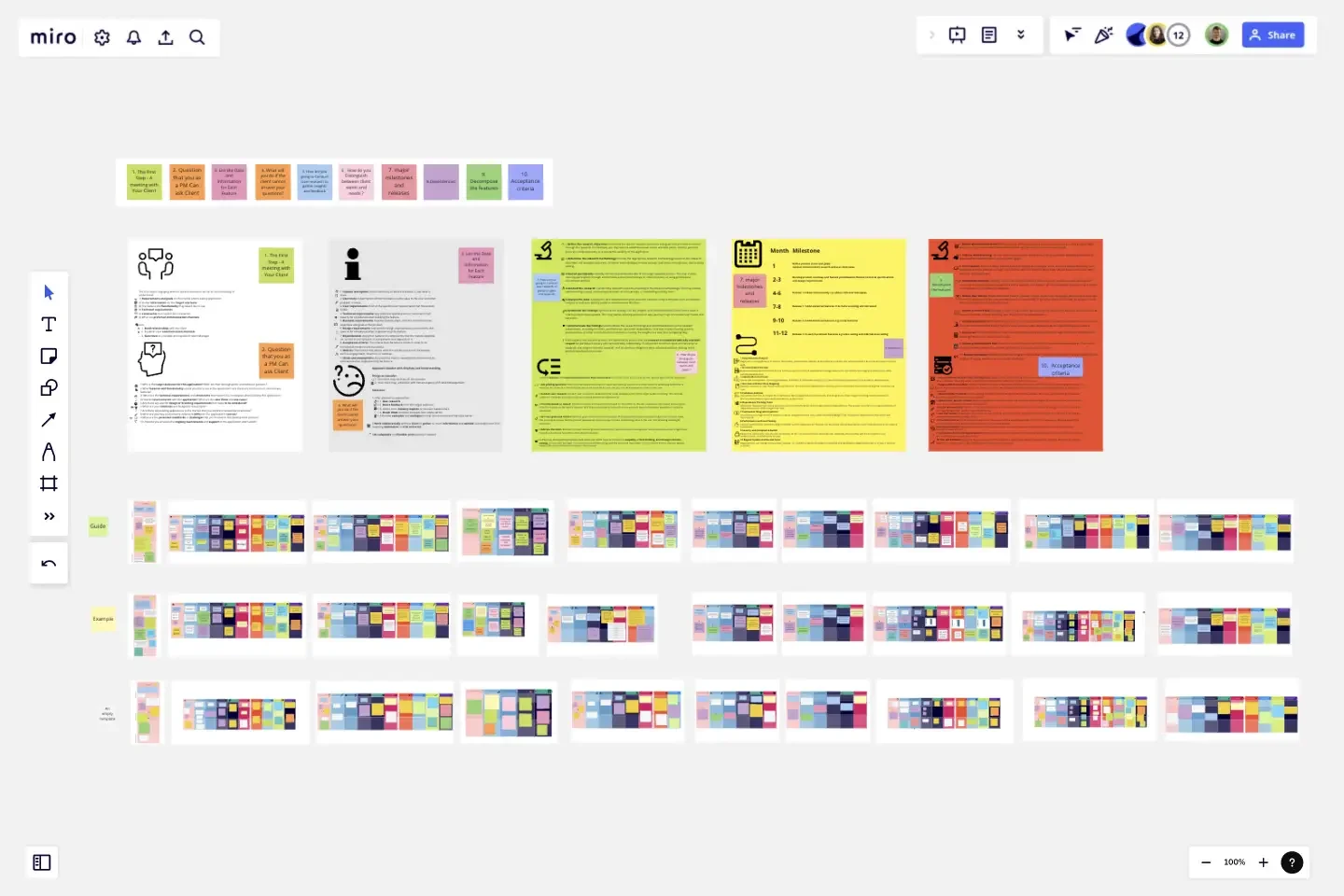Product Management - Product Flow
Streamline product development processes using Product Management - Product Flow template. Visualize stages, tasks, and dependencies for improved workflow.
Engaging with a Client
Purpose: Outline the initial approach to client engagement.
Content: Best practices for first meetings, communication strategies, and establishing rapport.
Questions for the Client
Purpose: Identify critical questions to understand the client's vision and requirements.
Content: Open-ended questions focusing on the client's goals, target audience, expected features, budget, and timeline.
Data Collection for Each Feature
Purpose: Specify the type of data needed for understanding each feature.
Content: Data types like user demographics, market analysis, and technical requirements for the calling and messaging features.
Information Collection for Each Feature
Purpose: Elaborate on the detailed information required for each feature.
Content: API integrations, hardware compatibility, and user interface requirements.
Handling Non-responsive Clients
Purpose: Strategies for proceeding when the client is unresponsive or unclear.
Content: Using industry benchmarks alternative research methods, reaching out to stakeholders.
Conducting User Research
Purpose: Detailing the approach for gathering user insights.
Content: Methods like surveys, interviews, focus groups, user personas, and usage scenarios.
Distinguishing Client Wants vs Needs
Purpose: Framework for identifying and prioritizing client requests.
Content: Techniques to differentiate between essential features and desirable additions, balancing business goals and user needs.
High-Level Timeline
Purpose: Outlining significant milestones and releases over 12 months.
Content: Gantt chart or timeline showing phases like planning, development, testing, launch, and post-launch support.
Top 10 Features with Dependencies
Purpose: Identify key features and their dependencies or constraints.
Content: Detailed list of features with associated technical, resource, or time dependencies.
Decomposing Features
Purpose: Break down each feature into manageable components.
Content: For each feature, list sub-features, tasks, and responsible teams or individuals.
Acceptance Criteria for a User Story
Purpose: Define clear criteria for evaluating whether a user story is complete.
Content: Specific, measurable criteria for one user story, demonstrating what success looks like for that feature.
This template was created by Mark V. Smetanin.
Get started with this template right now.
Event Planning Template
Works best for:
Planning, Workshops
Whether you’re planning a product launch, fully remote conference, or milestone event, the Event Planning Template will act as a visual checklist and map for all the details you need to consider before the big day. The Event Planning Template is an adaptable way to make sure the creative and strategic vision of your event doesn’t get lost in the details. By mapping out different sections - from the marketing plan, to the agenda, to snacks and swag for guests — you and your team can focus on the details most important to your functions, and collaborate as needed when overlaps occur.
Year Timeline Template
Works best for:
Timeline, Planning
The Year Timeline template provides a comprehensive view of annual events and milestones. Perfect for planning yearly goals, tracking progress, and scheduling important dates, this template helps you stay organized and focused throughout the year.
Fishbone Diagram for Marketing
Works best for:
Fishbone Diagram
Optimizing marketing strategies requires identifying underlying issues. The Fishbone Diagram Marketing template helps you systematically explore factors affecting your campaigns. Categorize potential causes into areas such as market research, product positioning, promotional strategies, and distribution channels. This structured analysis enables your team to pinpoint and address issues, enhancing marketing effectiveness and achieving better results.
Company Organization Chart
Works best for:
Org Charts, Operations, Mapping
The Company Organization Chart template enables clear visualization of hierarchical structures within an organization. It helps teams understand reporting lines, roles, and responsibilities, fostering transparency and alignment. With customizable features, such as color-coding and labeling, this template facilitates effective communication and decision-making across departments and levels.
Syllabus Template
Works best for:
Education
A Syllabus is a brief guide to your course, including expectations for your students, readings they will complete throughout the course, and a mission statement or course description. The Syllabus outlines any policies your students should follow during the course, rules and regulations that apply to them, and anything else your students should know. A Syllabus is a valuable tool for orienting your students, and it’s important the syllabus be clear and easy to follow. Use the Syllabus template to streamline the process of creating a simple, intuitive syllabus for your course.
Agile Board Template
Works best for:
Agile Methodology, Meetings, Agile Workflows
Part of the popular Agile framework, an Agile Board is a visual display that allows you to sync on tasks throughout a production cycle. The Agile Board is typically used in the context of Agile development methods like Kanban and Scrum, but anyone can adopt the tool. Used by software developers and project managers, the Agile Board helps manage workload in a flexible, transparent and iterative way. The Agile template provides an easy way to get started with a premade layout of sticky notes customizable for your tasks and team.
